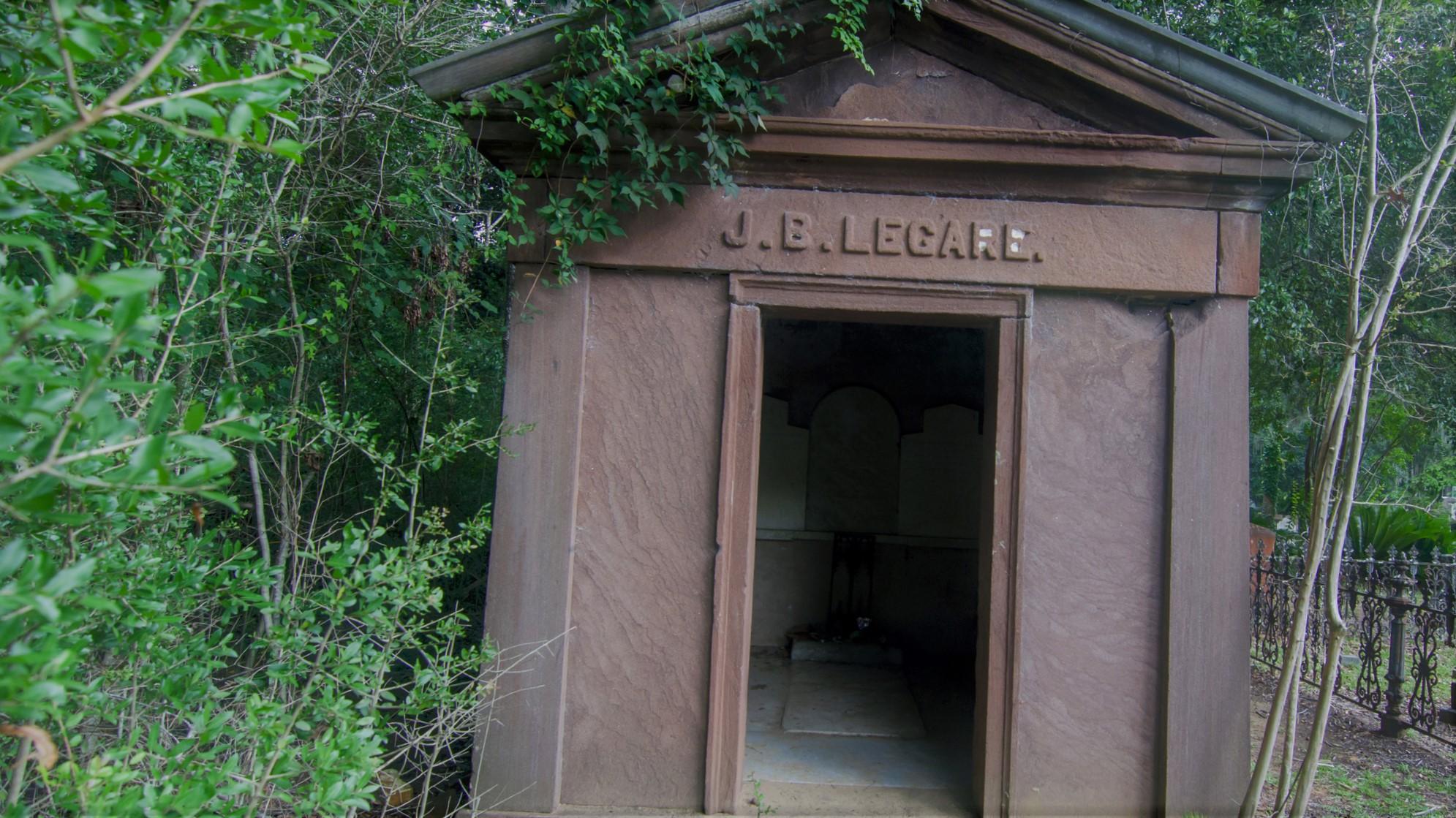Share the Lore!
By: Alex Postrado
The Open Tomb Of Julia Legare
What is the worst way to die?
Drowning? A plane crash? How about being buried alive?
You see, when death comes — regardless of the manner — we grieve for those it takes with it. And when it leaves, we try to move forward with what is left.
But how can someone go on after discovering that the loved one they lost and buried years ago was actually not dead when it happened?
That was the tragic fate of Julia Legare.
In 1852, almost like the plot of a horror movie, Julia was mistakenly buried alive by her family in a churchyard in Edisto Island, South Carolina.
And how it all happened is now the subject of tales and legends popular in the South.
Curious about it? Then, here goes.
The Story That Haunts Edisto Island
On an island near Charleston, in South Carolina, stands a holy building known as the Edisto Island Presbyterian Church.
At a glance, this church might look just like any other 18th to 19th century Greek Revival structure — complete with Palladian entrances and mighty Doric columns.
But, upon closer look, it is easy to see that this building is so much more than that.
Completed in 1831, the Presbyterian Church was erected for the Edisto Island congregation — one of the oldest Presbyterian communities in the U.S. — formed way back in 1685. And adjacent to it sits a far older burial ground, dating back to at least 1792.
Interestingly, both of these sacred structures remain active today.
And while this fact alone would have already made for an interesting historical visit, most of the tourists in Edisto Island usually stop by not for the raw history of the place — but rather the horror that comes with it.
This is where the legend of Julia Legare finally enters.

Who was Julia Legare?
If you look up her name or ask someone familiar with her story, you would immediately notice that the details in practically every version of her tale are vague and typically varying.
In any case, though, the plot revolves around her — Julia Legare.
More specifically, her death.
Born sometime around the 1800s, Julia Legare was said to be the wife of a wealthy plantation owner from South Carolina.
It is said that Julia had family on Edisto Island — the reason why she frequently goes there.
But, during one of her visits when she was 22, the young woman became very sick.
According to a popular account, it was diphtheria that Julia became infected with. Nevertheless, her health declined rapidly.
Soon, Julia fell into a coma — from which she never recovered.
Or at least, that was what they thought.
After days of anxious waiting — with Julia showing no sign of waking up — the family doctor ultimately pronounced her dead.
This mistake, unfortunately, marked the start of the tragedy.
Back in those days, medical science was not as advanced as it is now. And telling whether or not a person is — in fact — dead or simply in a comatose state was rather confusing.
Moreover, the embalming process we now have did not exist back then.
There was yet to be a way of preserving bodies, so burial ceremonies at the time were held at the earliest possible time to avoid decomposition.
For this reason, Julia was buried on the very day that she “died” in 1852.
Lovingly dressed and placed in the Legare family’s mausoleum, situated in the Edisto Island Presbyterian Church, Julia’s family bid her their last goodbyes — sealing the massive door made of marble behind them as they began to leave to start anew with their lives.
The Discovery of Julia’s Tragic Fate
The legend says that it would take more than a decade before anyone would know about the fatal mishap that fell upon Julia.
Unfortunately, by that time, it was far too late to rescue her.
When another death struck the Legares 15 years later, the crypt where Julia’s body was laid to rest was once again opened — only for the grieving family to be greeted by an utterly horrifying and heartbreaking discovery.
To their shock, they found Julia — her remains, huddled in a corner behind the tomb’s door instead of resting in her casket.
The realization quickly hits them. Their beloved Julia had been buried alive!
Still adorned by her now-bedraggled burial gown, no one could imagine the horror that Julia had woken up to — locked alone in a pitch-dark mausoleum with no food, water, or a way out.
The family soon found the last monument to Julia’s struggle and desperation in the form of fierce scratch marks and smears of dry blood all across the marble door.
Apparently, though, none of it helped her escape her doom.
The grisly discovery further shattered the Legare family, but they knew nothing else could be done to fix the mistake that led to Julia’s actual death.
So, in an attempt to settle everything and move forward, Julia was again entombed, along with her recently passed relative, believed by some to be her brother — with the door that once locked her away from survival, sealed once more.
Is Julia Legare’s Tomb Haunted?
What is intriguing about the tale of Julia Legare is that the crypt, in which she was said to be buried, actually exists in real life.
Located in the same Edisto Island Presbyterian Church from the story, Julia’s tomb is open for anyone to visit.
And by that, I mean, literally open! No more heavy marble door blocking its entryway.
It is believed that it was Julia, herself, who caused that.
The story says that each time the Legare family visited Julia’s grave, they found that the door to her tomb was open.
Whenever the church elders were alerted about it, the door would be secured in place. But, the next day, the tomb would be found eerily open again.
It was a mystery that kept on happening — over and over until people eventually decided to lay down their locks and chains, and give up.
No one could indisputably explain the case of Julia Legare’s tomb.
But some theorize that this was a manifestation of her will.
That due to how she met her gruesome end, she now haunts her resting place — making sure that no one could ever trap her again in the nightmare that ultimately killed her.
Nowadays, it is said that the original stone door is “nothing more than broken marble“, resting on the grassy ground outside Julia Legare’s tomb.
That is certainly a poetic way of concluding her story!
But, of course, a case of haunting is quite difficult — probably even impossible — to prove.
Although there seems to be one question that might help us with that:
Haunting or no haunting — was Julia Legare’s tragic death even real, to begin with?

Was the Legend of Julia Legare Real?
Sometimes, it is easier to believe a tale than to disprove it — because then you would need concrete facts to support your claim.
But a gripping ghost story? Sure, almost everyone seems to be up for that!
While it could be tempting to think that Julia Legare’s heart-wrenching fate was a true — albeit, appalling — account, backed by the very real Edisto Island and J.B. Legare mausoleum, historian and tour guide Dottie Thomas sets things straight.
According to her, it was true — Julia Legare was buried there. It was true that she died in 1852. And it was true that she was only in her early 20s when she passed.
But that was about everything the legend got right about her death.
Two years after Julia’s passing, her 4-year-old child followed. Two years later, her husband died, too.
There was no 15-year gap between the deaths and if anyone would visit the actual tomb, they would see three headstones.
One for Julia Legare — born Julia Georgiana Seabrook. One for her son, Hugh Swinton. And one for the planter, John Berwick Legare — Julia’s husband.
Skeptics of the story also say that the narrative involving Julia, being locked to her death in the crypt is unfounded — along with the alleged marks and bloodstains across the marble door, which — in itself — is already hard to believe, considering Julia would probably be weak by the time she awoke.
Still, the part that tells of the mysteriously opening door remains more or less real at this point.
It is said that no one could keep the door sealed in place, no matter the effort.
And while Julia might not have died from being buried alive, some say that her spirit might still be “unrestful due to her and her family’s untimely deaths”.
Possible? Maybe.
But, I guess, it is best to leave that thought open for now, as well.
References:
The Entombing Of Julia Legare Southern Ghost Stories: The Tragic Death, And Open Tomb, Of Julia Legare The Legend Of Julia Legare Tomb Of Julia Legare The Story Of The Haunted Mausoleum Of J.B. Legare On Edisto Island Tomb Of J.B. Legare
